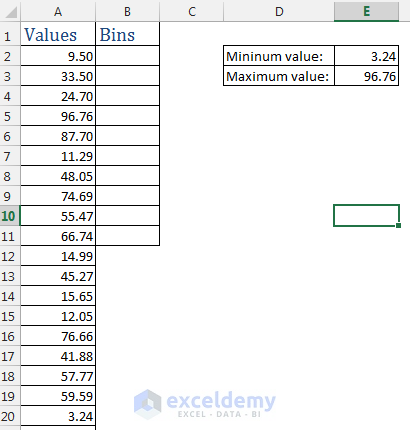

You can do this with this SUMIFS formula: Insert the class average into a new column in your original data table.This class name will be shown in your chart and should be easier to read. Furthermore, you create another column in table B with a class name.You will then return the class average, which you insert into column H. In number four, you later on use the SUMIFS formula.Recommendation: You could also make it dynamic, so that the user can define the class with (cell J1 in this example has the class with). You need to set a lower and an upper limit. The final chart will only refer to the last two columns of this table. For each class, it has the lower limit, the upper limit, the average, a class name as well as the number of items (here: countries). Table A contains your original table with an additional column for the class name.Please look at the image on the right-hand side. Therefore, you have to prepare a table with the class limits and insert the class into your existing data. The concept of the third method is to prepare your data in a way that you only have to insert a simple column chart. You can proceed with the layout of your chart. After clicking on OK, you see a chart similar to number 8.To change the values later on, repeat from step 5 above. “Starting at” is the minimum value, ending at the maximum value.Now right-click on any cell of the the “Row Labels” column.“Sum of…”), right-click into your PivotTable in the column of “Sum of Country”, click on “Summarize Values By…” and check “Count”. Make sure, that it says “Count of Country” instead of “Sum of Country”. Then drag and drop the item names (here: “Country”) into the “Values” section. If you can’t see the “PivotChart Fields” pane on the right-hand side, right-click into the empty PivotTable and click on “Show Field List”.ĭrag and drop the numeric values into the “Rows” section. Also, the “PivotChart Fields” pane on the right-hand side opens. You now see a blank PivotTable range and an empty PivotChart.Make sure the settings are correct (the correct table range and the location is selected).Click on “PivotChart” in the “Charts” section of the “Insert” ribbon.Follow these steps (the numbers relate to the pictures). You insert a PivotChart and use the function to group the data. The second method also works with Excel versions before 2016. Now you can proceed defining the layout, e.g. Number 6 on the screenshots shows the result, if you set the bin width to “1.0”, the overflow bin to “6.0” and the underflow bin to “2.0”.Excel then summarizes all items below the underflow bin into one column on your chart. Also important: Do you want to set an individual “underflow” bin or and “overflow” bin.Alternatively, you can let Excel define the bins automatically or define the number of bins.By default, it’s “Automatic”. You could switch it to “Bin width” and set the desired class width, e.g. Most important is probably the “Bin width”.Under “Axis Options”, you can set the main preferences. On the right-hand side, you’ll see the “Format Axis” pane.To achieve this, double click on the x-Axis. Now you can start fine-tuning your histogram.That’s it, you already got a histogram.Click on the histogram icon in the center of the “Insert” ribbon.Since Excel 2016, there is a built-in chart type called “histogram”.


 0 kommentar(er)
0 kommentar(er)
